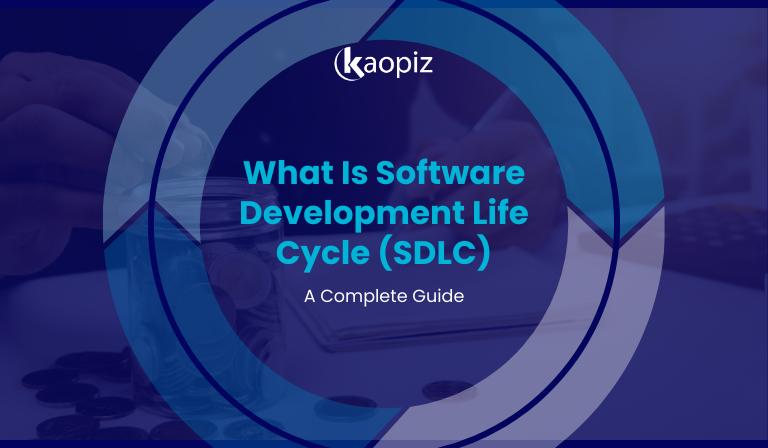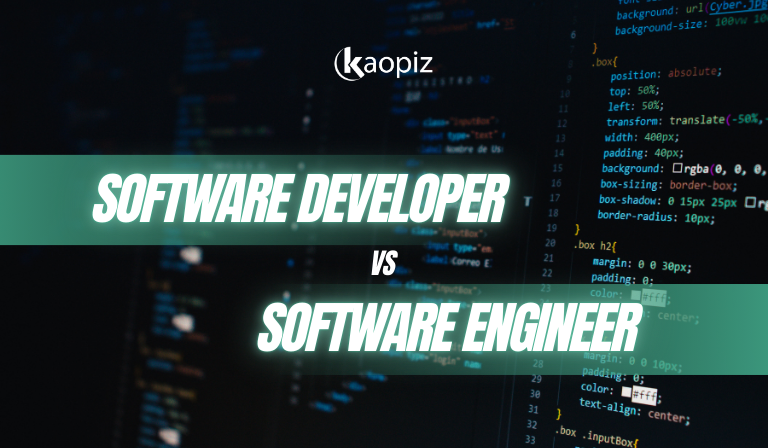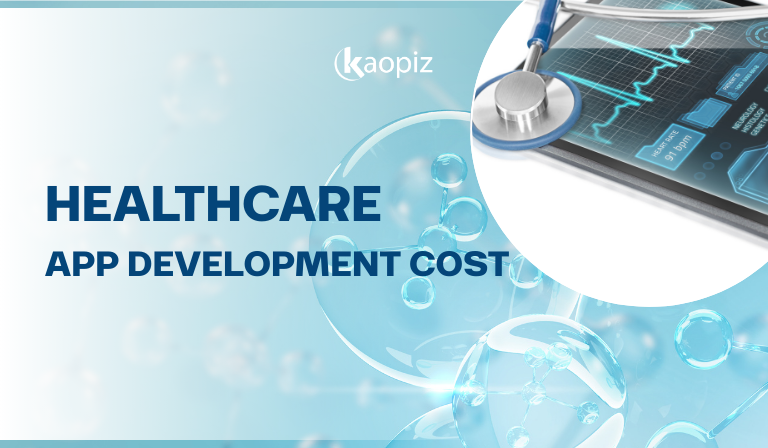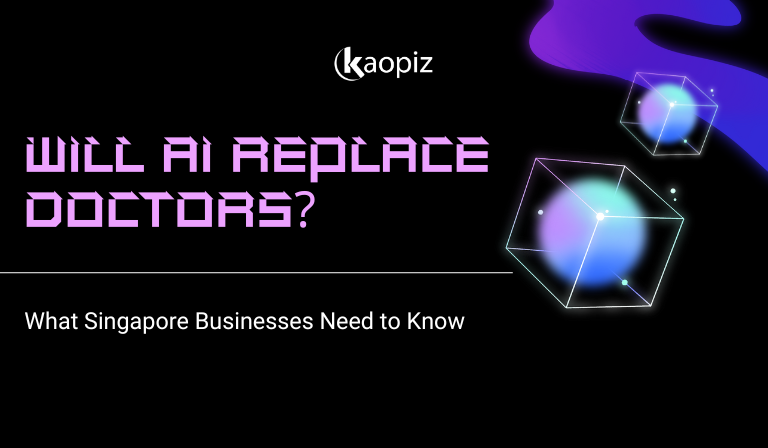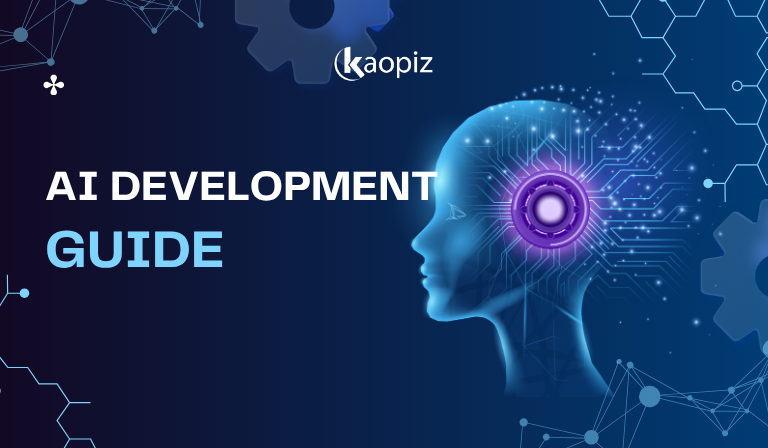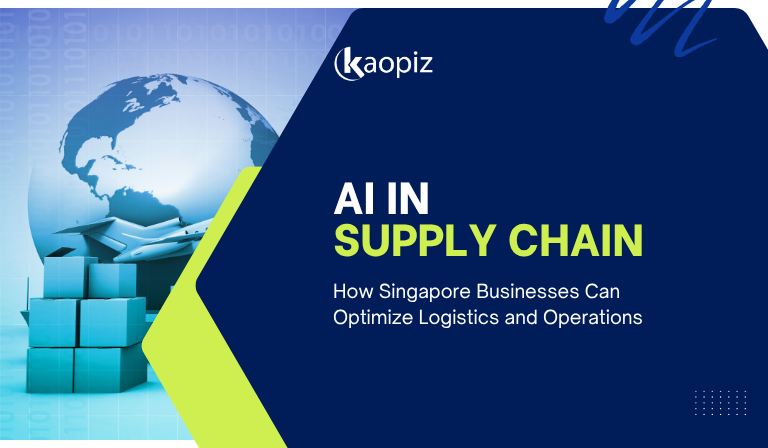Spatial Computing: Benefits, Use Cases, and Future for Singapore Businesses (2025 Explained)
Spatial computing is quickly emerging as a game-changing technology that merges the physical and digital worlds to create more immersive, intelligent, and responsive experiences. In 2023, the global spatial computing market was valued at $97.9 billion and is expected to grow at a 23.4% CAGR through 2028, with strong adoption across healthcare, manufacturing, and retail.
For Singapore businesses, this technology aligns closely with the nation’s Smart Nation goals, offering new ways to boost efficiency, engagement, and innovation. In this blog, we define spatial computing, explore how it works, its key benefits, real-world use cases, and how businesses can begin leveraging this powerful technology in 2025.
Table of Contents
- What Is Spatial Computing?
- How Does Spatial Computing Work?
- What Are the Benefits of Spatial Computing?
- 7 Real-World Use Cases of Spatial Computing in Singapore
- Challenges and Limitations of Spatial Computing
- How Singapore Businesses Get Started in Spatial Computing
- The Future of Spatial Computing
- Why Partner with Kaopiz for Spatial Computing Projects?
- Conclusion
- FAQs
What Is Spatial Computing?
Spatial computing refers to the set of technologies that enable digital systems to interact with and respond to the physical world in real time. It integrates components like AI, Augmented Reality (AR), Virtual Reality (VR), Metaverse, computer vision, IoT sensors, and 3D mapping to create immersive, responsive environments where digital content blends seamlessly into physical space.
Some spatial computing examples include:
- Apple Vision Pro: A headset that turns your physical space into an interactive 3D digital environment for work and entertainment.
- Smart Buildings: Sensors and cameras track occupancy and usage patterns to automate lighting, temperature, and energy use.
- Digital Twins: Real-time, interactive 3D replicas of factories, construction sites, or urban spaces used for simulation and monitoring.
- AR Navigation: Overlaying real-time directions onto streets and pathways using mobile AR.
- Virtual Prototyping: Architects and engineers visualize 3D building models at full scale before construction.
However, you might wonder: How is spatial computing different from Virtual Reality and Augmented Reality? Well, while VR and AR are integral to this technology, they represent only parts of a broader ecosystem.
- Virtual Reality offers fully immersive digital experiences, often replacing the user’s environment entirely.
- Augmented Reality enhances the real world by overlaying digital objects onto it through a screen or headset.
- Spatial Computing, by contrast, goes a step further—it not only overlays digital content but also enables that content to understand, react to, and affect the physical world through sensors, AI, and automation.
Spatial computing bridges the digital and physical worlds with context-aware decisions, not just displays. For businesses, this means higher levels of efficiency, interactivity, and innovation across industries like healthcare, retail, education, and manufacturing.
How Does Spatial Computing Work?
This technology operates through a continuous loop of:
- Sensing the environment using cameras, sensors, and IoT devices
- Processing data with AI, Machine Learning (ML), and edge computing
- Interacting with users through visual, audio, and tactile feedback
- Responding in real time with smart, automated actions
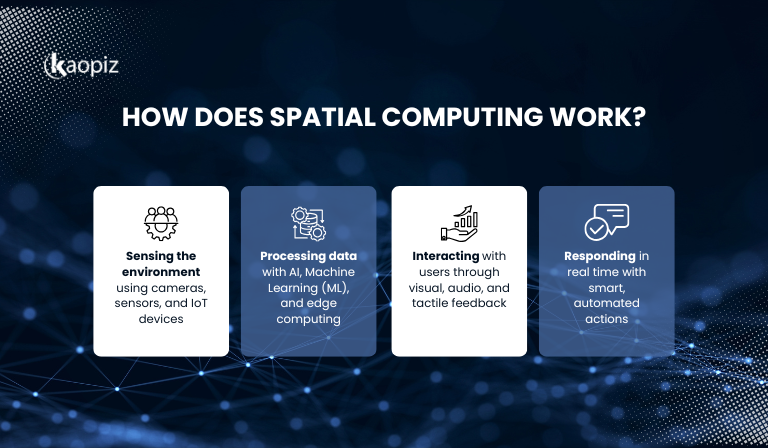
Spatial computing works by combining sensors, real-time data processing, and immersive technologies. It enables digital systems to understand and interact with the physical world. Here are the core technologies that make it possible:
- Computer Vision: Allows systems to “see” and recognize objects, people, and environments through cameras, like human vision.
- Sensor Fusion: Combines data from multiple sources like GPS, cameras, and motion sensors for accurate tracking and context awareness.
- Spatial Mapping: Builds a 3D map of the environment using LiDAR or depth sensors, enabling precise placement of digital content.
- ML: Analyzes spatial data to detect patterns, automate actions, and improve user experiences.
- Edge Computing: Processes data locally (on the device) for faster response times and real-time interaction.
- IoT Integration: Connects smart devices to gather and share environmental data for more dynamic control and automation.
- Haptic Feedback: Provides tactile responses (like vibrations) to make digital interactions feel physical and immersive.
- Robotics: Uses spatial data to navigate environments, perform tasks, or act as remote avatars.
What Are the Benefits of Spatial Computing?
Spatial computing AI bridges the physical and digital worlds, enabling smarter, more immersive interactions. It helps businesses enhance collaboration, training, and decision-making through real-time awareness and AI-driven automation.
Here are the key benefits:
- Enhanced User Experience: It creates more engaging, interactive, and efficient digital experiences (gestures, voice, or movement, etc.)—driving innovation across industries.
- Blending of Real and Virtual Worlds: By overlaying digital content onto physical space, this technology provides users with real-time, contextual information for better understanding and interaction.
- Improved Collaboration: Teams can engage with 3D models and digital tools in shared virtual environments, making remote collaboration more natural and effective.
- Immersive Training and Simulation: It supports realistic, risk-free training for complex tasks—ideal for industries like healthcare, manufacturing, and emergency response.
- AI-Powered Interactivity: Integrated AI enables spatial systems to understand environments, personalize content, and automate responses based on real-world input.
- Seamless 2D-to-3D Interfaces: Familiar 2D tools, like web browsers, can be used within immersive 3D environments, making adoption easier for users.
7 Real-World Use Cases of Spatial Computing in Singapore
Let’s explore 7 real-world spatial computing use cases where this technology is transforming industries across Singapore in 2025.
Retail & E-commerce
Spatial computing is revolutionizing the retail experience by merging physical and digital shopping environments. In Singapore, retailers are using AR-powered mirrors for virtual try-ons, spatial data to optimize store layouts, and interactive product displays that respond to customer movement.
In e-commerce, this technology enables 3D product visualization, allowing customers to view items in their actual space before purchasing, boosting confidence and reducing returns. These immersive experiences not only increase engagement but also drive higher conversion rates and brand loyalty.
Healthcare
This cutting-edge technology is opening new possibilities in healthcare by enhancing how professionals diagnose, treat, and monitor patients. In Singapore, doctors could use AR headsets to overlay real-time medical data or imaging scans during surgery, improving precision and decision-making on the spot.
For patients, spatial computing applications enable personalized rehabilitation programs and virtual assistants that support those with physical or cognitive impairments, helping them regain independence. These innovations are driving more efficient, accessible, and patient-centric healthcare experiences.
Manufacturing & Logistics
In Singapore’s push toward Industry 4.0, manufacturers and logistics providers can improve efficiency, accuracy, and safety with spatial computing. Digital twins of factory floors allow real-time monitoring and simulation of production lines, enabling proactive maintenance and optimized workflows.
In logistics, AR-powered systems guide workers through complex warehouse layouts, highlighting items for picking, packing, or inventory checks. Combined with robotics and IoT, this technology streamlines operations, reduces errors, and supports scalable smart supply chains.
Education & Training
Spatial computing provides highly engaging and interactive learning experiences that enhance knowledge retention and skill development. For example, medical students in Singapore can practice surgical procedures in realistic virtual environments, reducing risks while gaining hands-on experience.
In science, engineering, and technical fields, learners can build and test virtual prototypes, conduct simulations, and explore complex concepts in 3D, making education more immersive, accessible, and effective across classrooms and corporate training programs.
Public Sector & Tourism
Spatial computing is supporting Singapore’s Smart Nation vision by enhancing urban planning, public services, and tourism experiences. Government agencies can use digital twins to simulate infrastructure changes, manage traffic flow, or respond to emergencies with real-time spatial data.
In tourism, spatial computing powers interactive city guides, AR-enhanced museum exhibits, and immersive cultural experiences that bring landmarks to life. These applications help improve citizen engagement, streamline city operations, and create more memorable experiences for both locals and visitors.
Gaming and Entertainment
This technology transforms gaming and entertainment by creating deeply immersive experiences where users interact with virtual worlds in natural, intuitive ways. Instead of using traditional controllers, players can use hand gestures, eye tracking, or body movement to control avatars and manipulate digital objects.
With devices like Apple Vision Pro, users can experience live events—such as NBA games—as if they were sitting courtside or relive personal memories in vivid 3D. From mixed reality games to immersive media, spatial computing is redefining how people play, watch, and connect with digital content.
Architecture and Design
Spatial computing empowers architects and designers to create, visualize, and modify 3D models directly within real-world environments, eliminating the need for physical prototypes. This accelerates the design process, reduces costs, and allows for more rapid iteration and client feedback.
Designers can also build virtual prototypes of products and test their form, function, and ergonomics in various physical settings, making spatial computing a valuable tool for improving both design accuracy and user experience.
Challenges and Limitations of Spatial Computing
While spatial computing offers exciting possibilities across industries, its adoption is still limited by several technical, practical, and market-related challenges. Understanding these limitations is key to planning realistic, scalable implementations.
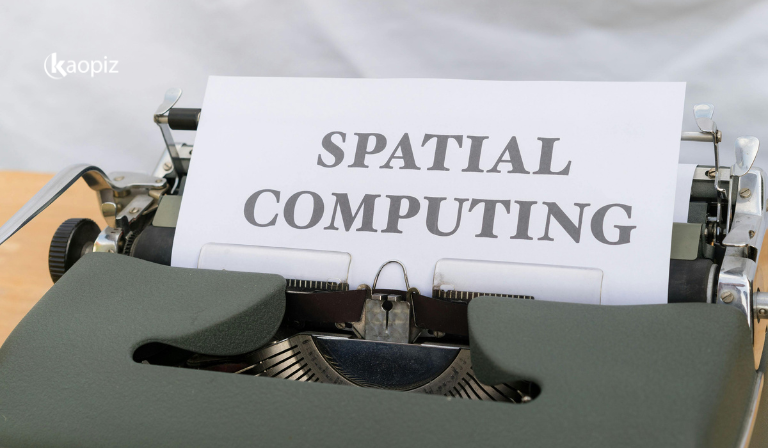
Here are the key challenges of spatial computing:
- High Cost: AR/VR headsets, sensors, and spatial content creation are still expensive, making initial adoption costly, especially for small and mid-sized businesses.
- Lack of Interoperability and Integration: Most spatial computing apps are siloed and lack interoperability. Without unified protocols or tools, integration into existing workflows remains difficult.
- Uncomfortable and Unattractive Wearables: Current head-mounted displays are heavy, unattractive, and have short battery life, reducing usability for extended periods or in public settings.
- Lack of a Killer App: While the technology is promising, there’s no single use case driving mass adoption. This slows investment and limits broader ecosystem growth.
- Data Privacy and Ethical Concerns: Spatial systems collect sensitive real-world data. Without proper data governance, there’s a risk of misuse, surveillance, or compliance issues.
- High Technical Requirements: The experiences demand powerful computing and low-latency networks. Inconsistent infrastructure can disrupt performance and user experience.
How Singapore Businesses Get Started in Spatial Computing
For CIOs and technology leaders in Singapore, this technology is more than a buzzword—it’s a strategic opportunity to drive innovation, productivity, and long-term digital growth. As adoption accelerates globally, businesses that take early steps will be better positioned to lead in an increasingly immersive, data-driven world.
Here’s how to get started:
- Assess Current Infrastructure: Evaluate your existing digital architecture to identify where this technology can complement or extend current initiatives, such as digital twins, IoT, or AI-powered analytics.
- Start with Focused Use Cases: Choose practical, high-impact areas like immersive training, remote collaboration, or smart facility management. Begin with small pilots or prototypes to validate outcomes before scaling.
- Invest in Team Readiness: Equip your workforce with the skills to design, implement, and manage spatial systems. This may include training in 3D modeling, AR/VR platforms, or spatial UX design.
- Prioritize Interoperability: Ensure these solutions can integrate seamlessly with existing enterprise systems. Build data pipelines that connect multimodal inputs—visual, spatial, and behavioral—into a unified workflow.
- Ensure Governance and Compliance: As spatial systems collect real-world user data, align with Singapore’s PDPA and implement strong digital ethics and data governance frameworks from day one.
- Work with Trusted Technology Partners: Collaborate with experienced vendors like Kaopiz to reduce development time, lower risk, and ensure enterprise-grade scalability.
The Future of Spatial Computing
In 2025 and beyond, spatial computing is rapidly unfolding, driven by advances in AI, AR glasses, 5G, and edge computing. As devices become more lightweight and software more intelligent, it will shift from niche to mainstream across industries.
In Singapore, sectors like manufacturing, healthcare, and urban planning are set to benefit from real-time spatial insights, immersive interfaces, and smarter automation. Agentic AI will further enhance these systems by enabling predictive, personalized, and context-aware interactions.
As part of the Smart Nation vision, Singapore is well-positioned to lead innovation in the region. Businesses that adopt early will gain a significant edge in productivity, user experience, and digital transformation.
Why Partner with Kaopiz for Spatial Computing Projects?
Kaopiz is a trusted IT outsourcing partner for businesses looking to explore or scale spatial computing solutions. With deep expertise in AI development and custom software development, we help organizations design and build immersive, data-driven applications that enhance real-world experiences.

With delivery centers in Vietnam, Kaopiz offers high-quality development at cost-effective rates—ideal for prototyping, MVPs, and scalable enterprise deployments. Our agile approach, combined with strong project governance, ensures faster time-to-market without compromising quality.
Having successfully completed 500+ projects for 150+ clients across Japan, Singapore, the US, and Europe, we understand how to build solutions that meet the unique demands of global enterprises. If you’re ready to explore the potential of spatial computing, Kaopiz is your strategic partner to help you innovate with confidence and deliver real business value.
Conclusion
Spatial computing is no longer a distant concept—it’s here, and it’s already reshaping how businesses in Singapore and around the world operate in 2025. From immersive training and smarter logistics to enhanced retail and urban planning, this technology unlocks new levels of interactivity, insight, and innovation.
While there are still challenges to overcome, the opportunities are far greater. By starting with focused use cases and the right technology partner, companies can unlock real value and gain a competitive edge in the digital era.
FAQs
Common devices include AR/VR headsets such as the Apple Vision Pro, Microsoft HoloLens, and Meta Quest, as well as smartphones and tablets equipped with LiDAR sensors. These devices use cameras, sensors, and advanced processors to map space and enable real-time interaction with digital content.
Spatial computing extends augmented reality by enabling systems to understand, interpret, and respond to the physical environment. While AR overlays digital elements onto the real world, spatial computing adds layers of intelligence—such as spatial mapping, gesture tracking, and AI-powered context awareness—to create richer, more interactive experiences.
Development timelines vary based on project complexity. A basic prototype or proof of concept can take 4–8 weeks, while full-scale enterprise solutions may require 3–6 months or more. Working with an experienced partner like Kaopiz can streamline the process and reduce time to market.

















